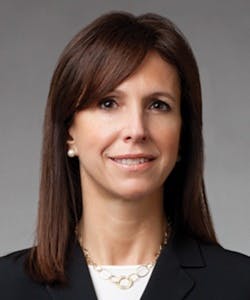Within the healthcare industry, including healthcare IT, there is an enduring stereotype that IT professionals are mostly male, and also Sci-Fi geeks. But, this doesn’t reflect the current health IT workforce, which is increasingly diverse, both along gender and racial lines.
One informatics leader, Molly Greek, director of enterprise applications at UC Davis Health in Davis, California, recalls a female colleague who went to an IT department and noticed that all the conference rooms were named after Star Wars characters, mostly male characters, and, in the same office, all the visuals on the walls depicted strong, masculine imagery.
"You have to be aware of the images that you’re putting up on the walls, and the way you name the conference rooms; you have to make sure it’s appealing to all groups of people,” notes Greek, who is an industry thought leader on diversity issues in health IT. “You want to make sure you’re not just representing something that is stereotypically something that a male might enjoy, or that a white person might enjoy.”
It’s one small example, but the need for more diversity and inclusion in the healthcare and health IT industries has been gaining more attention as a critical workforce and leadership issue.
Within healthcare, the gender imbalance in organizational leadership has been well documented. According to a 2014 study by The Advisory Board, women make up 80 percent of healthcare workers but only 40 percent of executives.
For the health IT industry, recent research into compensation trends has found that the average salary of health IT professionals varies by gender and race, with both female health IT professionals and health IT professionals of color paid less than their respective white male peers. On average, across all positions and years in a position, female health IT professionals make 18-percent less than their male peers, and IT professionals of color make 12-percent less than their white peers, according to the 2018 U.S. Compensation Survey by the Healthcare Information and Management Systems
Society (HIMSS).
While male health IT professionals average $123,000 a year, female health IT professionals average $100,000—which comes out to 82 cents for every dollar their male colleague makes, according to the 2018 compensation survey, which is based on the
feedback from 885 U.S. health information and technology professionals.
The 2018 HIMSS U.S. Compensation Survey, which provides a profile of salary and compensation experiences of U.S. health information and technology professionals representing an array of organizations and roles, found that gender pay disparity has persistently existed across a 12-year period (2006-2018).
In 2016, HIMSS released a longitudinal assessment that found female health IT workers in the United States have been consistently paid less over the past 10 years than their male peers, with the pay gap disparity worsening over time. In fact, the gender pay gap within the health IT industry has made almost no progress over the past 12 years, returning to its 2006 level after dipping below 80 percent from 2009 to 2016, according to the HIMSS compensation survey data.
The one positive trend is that the pay gap appears to be closing after years of widening and has returned to its 2006 level, when HIMSS began tracking compensation trends, notes Lorren Pettit, vice president, HIS and research for HIMSS. However, overall, Pettit notes, “The data that we have indicates that gender pay disparity is persistent and consistent. Consistently, we do see this gap.” He adds, “We have a way to go, but I would expect to see the pay gap continue to narrow as the economy churns.”
Lorren Pettit
Gender and racial pay gaps in health IT are a critical issue, but salary inequities are part of a much broader and much more significant issue around equality, diversity and inclusion in the workforce.
A survey by global technology association ISACA, looking more broadly at gender barriers in the technology field, found that wage inequality compared to male colleagues, workplace gender bias and a shortage of female role models were the main barriers that women face working in technology. For that study, “The Future Tech Workforce: Breaking Gender Barriers,” ISACA polled 500 female members of its association, with 6 percent of respondents coming from the healthcare sector.
Women make up 40 percent of the world’s workforce, according to the World Bank, and that number is as high as 59 percent in some countries. According to Payscale, the technology field is male-dominated at all levels—only 28 percent of managers/supervisors in tech are women compared to 48 percent in non-tech industries and women only make up 32 percent of directors in the tech field compared to 49 percent in the non-tech industry. Further, only 21 percent of executives in tech are women compared to 36 percent in non-tech industries.
Making the Case for Diversity Initiatives, and Current Progress
Beyond the ethical, moral and legal considerations that support having a more diverse workforce, research has shown that a business case can be made for increased diversity within organizations. A 2015 McKinsey report on 366 public companies found that those in the top quartile for ethnic and racial diversity in management were 35 percent more likely to have financial returns above their industry mean, and those in the top quartile for gender diversity were 15 percent more likely to have returns above the industry mean.
According to ISACA, research has shown that more women lead to greater innovation and enhanced profitability. In a 2016 Peterson Institute for International Economics working paper, for example, researchers found that having women in leadership positions aligned with a 15-percent increase in profitability, on average. In short, making efforts to increase diversity is a good business decision.
“Companies that take gender parity seriously are the ones that have a competitive advantage over others,” Pettit notes.
Industry thought leaders note that awareness of diversity issues in the workforce has been increasing within the health IT industry, yet, as compensation surveys indicate, there is much more work that needs to be done.
Hillary Ross, senior partner, managing director, IT practice, and Tammy Jackson, senior associate, IT practice, at Oak Brook, Ill.-based executive search firm Witt/Kieffer, note that diversity and inclusiveness are increasingly featured in sessions and panel discussions at health IT conferences sponsored by industry organizations like HIMSS and CHIME (the College of Healthcare Informatics Management Executives). “It is clear that there are initiatives indicating the importance to emphasize greater diversity in health IT. People see a strong and definite need to bring more diversity, reflecting all dimensions including women, minorities, national origin and sexual preferences, into top leadership positions,” Jackson says.
“In the work our firm does in recruiting IT leaders, clients always ask for and expect a diverse slate of candidates,” Ross says. “They want to diversify their leadership teams in general, and therefore are seeking diverse hires for CIOs, CMIOs (chief medical information officers), CISOs, and other IT positions. As we know, there are not as many diverse candidates as organizations would like, so efforts that promote diversity at all levels of health IT and healthcare are so important. It starts with a commitment at the senior level, a plan and goals. The healthcare industry is prioritizing this.”
Hillary Ross
The Institute for Diversity and Health Equity, an affiliate of the American Hospital Association (AHA), has been tracking efforts within the healthcare industry to promote diversity in leadership and governance. A 2015 benchmarking study, the most recent one available, found that hospitals have made little progress in increasing the diversity of their leadership teams and governing boards since the 2013 study. Minorities represent a reported 32 percent of patients in hospitals that responded to the survey, and 37 percent of the U.S. population; however, minorities constitute just 14 percent of hospital board members, the same percentage as 2013, according to that study.
A leadership and governance team that reflects the community it serves helps ensure that the community’s voice and perspective is heard. It also encourages decision-making that is conducive to best care practice, the Institute for Diversity and Health Equity study stated.
Leading health systems and healthcare organizations are taking proactive steps to address diversity and inclusiveness, including hiring chief diversity officers, developing dedicated departments, such as the Cleveland Clinic’s Office of Diversity and Inclusion,
and other organization-wide initiatives.
“Over the past several years our firm has seen increased interest from clients about recruiting chief diversity officers and related positions, and there are more CDOs in healthcare today,” Ross notes. “As hospitals and health systems seek to better represent patients and their communities, they want someone within the organization who is dedicated to promoting diversity and inclusion—who can work with leaders across the organization and help shape the culture.”
A critical key to adding the role is making sure it has support and resources across the organization, notes Jackson, citing Witt/Kieffer’s 2017 survey report on CDOs in healthcare and education. “A CDO should not be expected to ‘fix’ things but rather build consensus and encourage organizations wide collaboration and commitment,” she says.
Tammy Jackson
Each year, DiversityInc ranks the nation’s top hospitals and health systems for employee diversity, as part of its annual Top 50 Companies for Diversity list. Mount Sinai Health System, Methodist Health System and Henry Ford Health System were ranked in the top three in the 2018 list, and Cleveland Clinic was in the top 10, which indicates these organizations scored well in talent pipeline, talent development, leadership commitment and supplier diversity.
This year, DiversityInc named Kaiser Permanente among five companies inducted into its first-ever Top 50 Hall of Fame. Kaiser, which was ranked No. 1 in 2016, is moving forward with a number of initiatives to advance equity in hiring and leadership development, according to DiversityInc. Kaiser Permanente’s diversity efforts have produced better healthcare outcomes for their customers for years, DiversityInc stated.
Accelerating Diversity Efforts in Health I.T.
Within the health IT and informatics fields, industry stakeholders and change makers are leading a number of innovative initiatives to support and promote diversity efforts, within their organizations as well as industry-wide.
Industry organizations such as HIMSS, CHIME, the National Association of Health Services Executives (NAHSE), and the Institute on Diversity and Health Equity, to name a few, are taking steps to educate the healthcare and health IT industries about diversity issues. Through its compensation and pay disparity studies, HIMSS is raising awareness that pay disparities exist, while also providing education on mentorship and career development. HIMSS also sponsors the Most Influential Women in Health IT recognition and hosts Women in Health IT Mentor meetup events.
CHIME leads a number of diversity and mentorship initiatives, and the Institute for Diversity and Health Equity offers strategies, resources, and data, as well as a professional network of experts, to help healthcare leaders accelerate and improve their organization’s equity, diversity, and inclusion objectives.
Then, there are a number of informatics leaders, such as Greek and Janet Corral, who are passionate about diversity issues and are working collaboratively with their colleagues to advance diversity and inclusion.
Greek serves as the co-chair of the Diversity and Inclusion Workgroup within the Group on Information Resources (GIR), as part of the Association of American Medical Colleges (AAMC). Greek, who spoke about diversity issues in health IT at the Beverly Hills Health IT Summit in November, sponsored by Healthcare Informatics, says there is a misconception that only experts can lead diversity efforts.
Molly Greek
Greek notes that she is not a chief diversity officer but has extensively researched the topic of diversity and inclusion, and through this research, she discovered how much there is to learn. “None of us have to be the expert, we just have to acknowledge that we’re not the expert and that we want to learn more,” she says, And, she adds that many people are interested in the topic of diversity but assume they aren’t informed enough to be involved in an initiative or to lead an effort. “People will say, ‘I’m for diversity but I don’t know what that means. What I am supposed to do?”
Corral, an associate professor of educational informatics at the University of Colorado in Denver and the director of digital education, says that as she has risen through the ranks into a hiring position she has become more aware of the need to address diversity. “I now realize that every single person we hire matters for moving the needle at our organizations and that has changed me from acknowledging the issue to advocacy.” Corral is involved in an upcoming Academic Medical Centers IT Forum at the UC campus in which use cases will be used to spark discussions on diversity issues. “The first big thing we’ve done here is to realize that everybody is on a journey, and we focus on creating an open space for everybody to share.”
Janet Corral
Many industry thought leaders note that having C-suite level and board level leadership support for diversity efforts plays a key role in an organization’s journey to become more diverse and inclusive. Greek notes that at UC Davis Health, advancing diversity is a core mission and approached in a comprehensive manner across the organization.
In partnership with AAMC, the Diversity and Inclusion Workgroup developed an action-oriented list of recommendations for health IT executive leaders and managers—10 Ways to Encourage Diversity in Informatics. One guideline is to lead by encouraging wellness, self-care and family. “We lose a lot of women from the workforce every year. Women have a lot of family responsibilities and if their work doesn’t offer remote work options or flexible work hours, they end up leaving,” Greek says.
Another recommendation to address diversity issues is to focus on employee training, such as offering unconscious bias training, which can include tools like implicit association tests to identify an individual’s unstated biases and then address those biases.
Health IT leades also should include vendors who represent diversity in their preferred list, for example, minority-owned, female-owned, and veteran-owned businesses.
Recruiting, hiring and promotion practices play a large role in diversity and inclusion efforts, and this often starts before the hiring process, with the job description and ensuring that it’s well-worded to recruit a diverse and inclusive number of applicants, Greek and Corral note.
“I recently learned that our position descriptions are not women-friendly,” says Greek, citing research that indicates women will only apply for jobs if they feel they are 95 to 100 percent qualified, while men will apply for jobs if they feel they are at least 75 percent qualified. “When we write a job description where we say, we want somebody who can do everything, there’s a distinction between what we want and what we will accept. With that kind of description, we are discouraging women, because, in general, women won’t apply if they feel that they don’t have all the skills," Greek says.
It is critical for health IT leaders to include diverse and inclusive candidates, not just one diverse candidate, but multiple candidates, in their candidate pool and to ensure diversity on the hiring committee, Corral says.
Ross agrees, noting that candidates who are interviewing and considering a position will also be assessing whether there is diversity in current staff and leadership, on the hiring committee, and whether they will fit within the organizational culture. "Also, in this era of community-centered care, does the organization truly support and reflect its community, or does it just pay lip service?” Ross asks. “In recruiting, it is important to cast a wide net, even across different industries, in order to increase the number of candidates available.”
Health IT leaders also should provide growth opportunities though mentorship or sponsorship. What’s more, men and women alike should work to enhance gender diversity in leadership by taking on sponsorship roles, thought leaders say. Other efforts include sponsoring an inclusion group at healthcare organizations, such as a ‘Women in IT’ group, or making diversity inclusion a formal staff goal, as Greek has done at UC Davis Health.
Addressing pay inequities, which research has shown do exist, also is imperative, thought leaders say. The HIMSS 2018 compensation study indicates the gender pay gap has particularly worsened for female health IT executives since 2011, who now make 22 percent less than their male counterparts. Females in clinical management roles experience the most egregious gender pay disparities, making 59 cents on the dollar compared to men in the same position. What’s more, older females experience greater pay disparities than their younger colleagues in the health IT field.
Racial pay disparities are equally prevalent, the HIMSS survey data shows. A troubling trend identified in the HIMSS survey report is that female health IT professionals of color experience what HIMSS calls “double jeopardy,” with an average salary that is nearly $36,000 less than that of a white male colleague.
Organization leaders need to hold up a mirror and look internally at their salaries, HIMSS’ Pettit says. “Organizations need to do an internal audit. Do pay gaps exist in their organization? And, as part of the audit, they need to look at the composition of their leaders—do they reflect the profile of the U.S., the profile of their customer base?”
Overall, health IT thought leaders agree that the first step to addressing diversity issues is to recognize that the problem exists, that there is room for improvement and then, next, take action to address it.
“It will be critical for health IT leaders to create an open dialogue in the workplace about the obstacles they may face with recruiting and retaining diverse leaders. It will also be important to have executive sponsorship in the form of professional support and networking opportunities for young leaders. Organizations have to make diversity a strategic priority and must understand the importance of training, developing and building a diverse leadership bench of high-potential talent,” Witt/Kieffer’s Ross and Jackson say.







